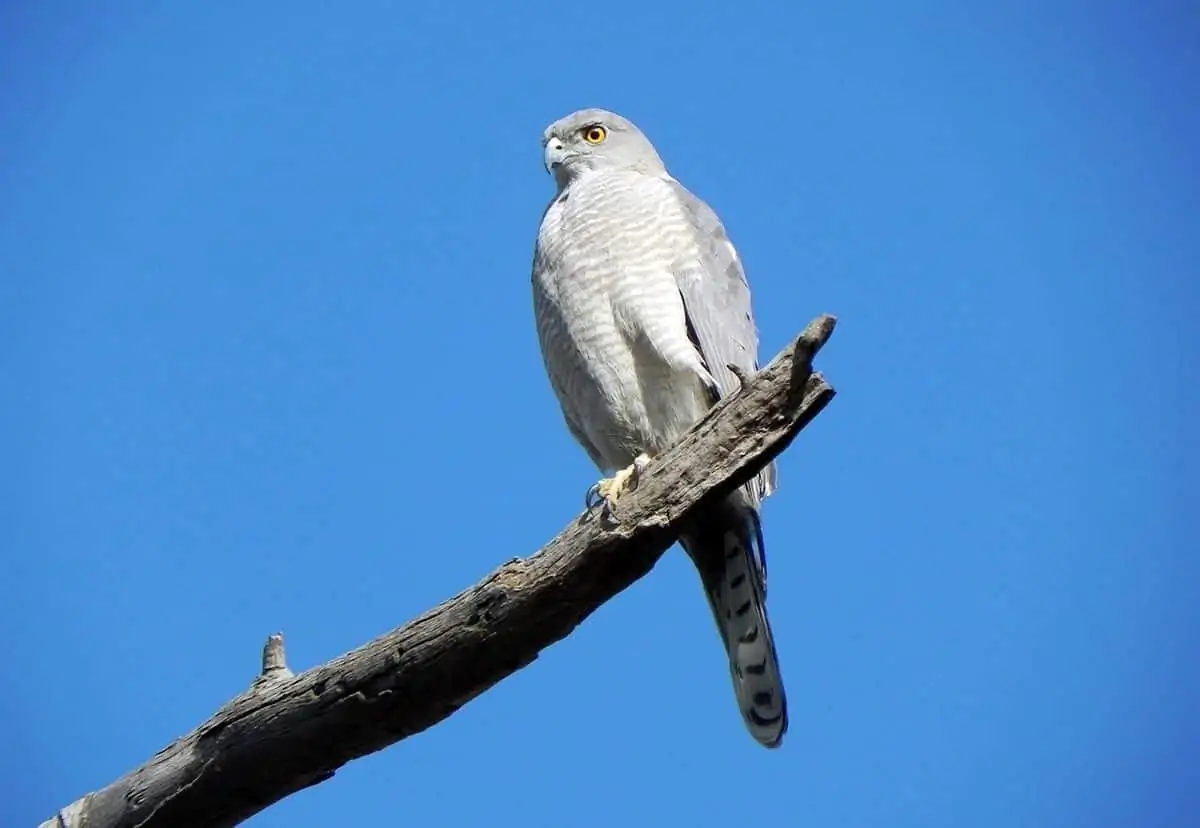Did you know small birds of prey, like kestrels and sparrowhawks, serve as vital environmental indicators? Their survival rates can hint at ecosystem health. Let’s delve into their fascinating world and uncover why these tiny predators are truly mightier than they appear. Stick around to explore the key roles they play in our world and why their protection is urgent.
Table of Contents
- 1 Table of the most interesting small birds of prey in the US
- 2 Key Takeaways
- 3 Elf Owl
- 4 Northern Saw-Whet Owl
- 5 Bicolored Hawk
- 6 Black-Thighed Falconet
- 7 Shikra
- 8 Eurasian sparrowhawk
- 9 Roadside Hawk
- 10 Pygmy Falcon
- 11 American Kestrel
- 12 Merlin
- 13 More small birds of prey from around the world
- 14 The Environmental Significance of Small Birds of Prey
- 15 List of small birds of prey broken down by types
- 16 Understanding Small Raptors: The Mighty Hunters of the Bird World
- 17 Conclusion
- 18 FAQ
- 18.1 What ecological roles do tiny birds of prey fulfill?
- 18.2 Which bird holds the title of world’s smallest owl?
- 18.3 How do miniature raptors hunt effectively despite their size?
- 18.4 Where can you find diminutive birds of prey around the world?
- 18.5 Why are tiny owls classified as raptors?
- 18.6 How do environmental changes impact smaller birds of prey?
- 18.7 What makes the Merlin notable among British raptors?
Table of the most interesting small birds of prey in the US
| Species | Size | Diet | Most Interesting Fact |
|---|---|---|---|
| American Kestrel | 22-31 cm | Insects, small mammals | The most colorful raptor in the world |
| Sharp-shinned Hawk | 24-37 cm | Birds | Known for navigating dense forests while flying |
| Cooper’s Hawk | 35-46 cm | Birds | Adults have red eyes |
| Merlin | 24-33 cm | Birds, insects | Capable of reaching speeds up to 50 km/h |
| Northern Pygmy Owl | 15-17 cm | Small mammals, birds | Despite its size, it can take down prey larger than itself |
| Eastern Screech Owl | 16-25 cm | Small mammals, birds, insects | Can have red or gray color morphs |
| Western Screech Owl | 19-23 cm | Insects, small mammals | Despite its name, it doesn’t really screech |
| Burrowing Owl | 19-28 cm | Insects, small mammals | Unlike most owls, it is active during the day |
| Elf Owl | 12.5-14.5 cm | Insects, scorpions | The smallest owl in the world |
Key Takeaways
- Small birds of prey serve as vital environmental indicators, with their survival rates directly reflecting ecosystem health and environmental changes
- The Elf Owl, weighing just 1.4 ounces, holds the distinction of being the world’s smallest owl and one of the tiniest raptors
- Many small raptors have developed specialized hunting techniques, from the Pygmy Falcon’s group living to the American Kestrel’s energy-conserving hovering method
- Small birds of prey are found across diverse habitats worldwide, from the forest-dwelling Eurasian Sparrowhawk to desert specialists like the Burrowing Owl
- Despite their small size, these powerful predators play crucial ecological roles in controlling populations of insects, small mammals, and other birds
Elf Owl
Habitat: Desert and riparian areas
Size: 5.7 inches long with a wingspan of 10.5 inches
Weight: 1.4Oz
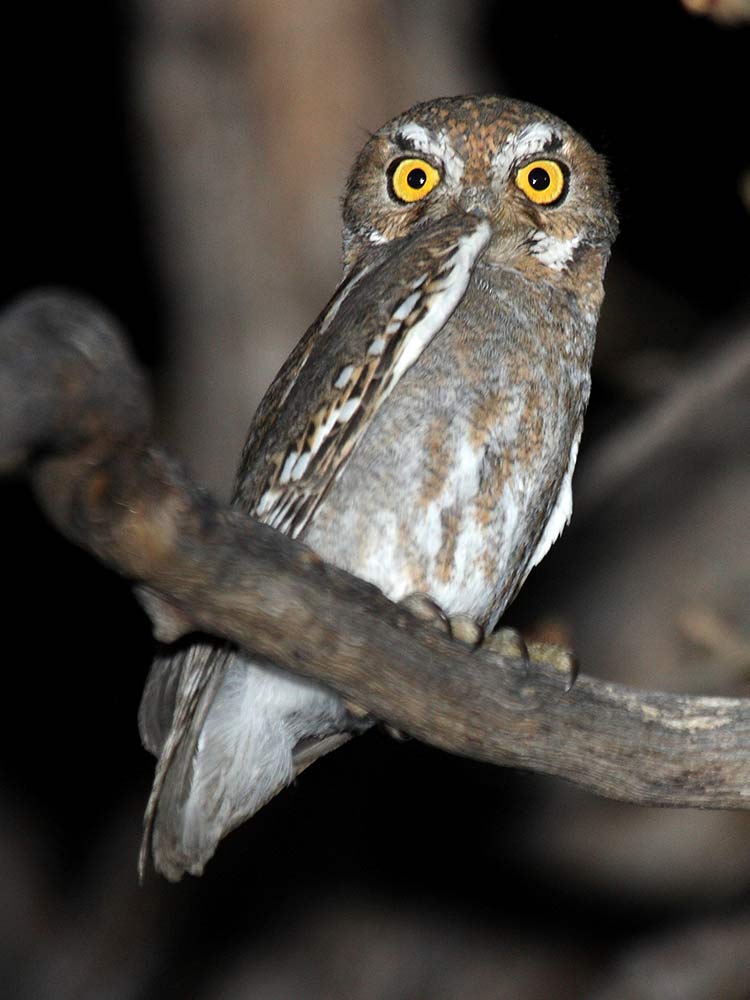
The elf owl is the world’s smallest and lightest owl. It is a small grayish-brown bird about the size of a sparrow. You will have better luck spotting it in the Southwestern United States, the Baja California peninsula, and central Mexico. The elf owl mostly inhabits the holes of woodpeckers but can also be found nesting in natural tree cavities. It is nocturnal and mostly feeds on insects.
Northern Saw-Whet Owl
Habitat: Coniferous forests
Size: 8.7 inches long with a wingspan of 22.2 inches
Weight: 1.9 to 5.3oz
This is yet another small owl native to North America. The Northern Saw-Whet Owl is considered the smallest owl species in North America. You will have better luck finding it in dense thickets or conifers. They mostly nest at eye level although it is not uncommon to find them 20 feet up. While they are raptors too, they are preyed upon by larger owls and other raptors. They are nocturnal and feed mostly on small mammals. Read more about the owl meaning here.
Bicolored Hawk
Habitat: Rain forest, drier thinned forest, and palm savanna
Size: 18 inches long
Weight: 7.1 to 15.9oz
The bicolored hawk is a species of bird of prey found in woodland, forest, wooded savanna, and plantations. While not an easy-to-find raptor, you will have better luck in Mexico, north and central-south America, and Central America. You will not find it in altitudes above 8,900 feet. The bicolored hawk mostly feeds on smaller birds, small mammals, and reptiles (and has a distinct call, read about the meaning here) (and has a distinct call, read about the meaning here). They may also follow monkeys to feed on the insects that are exposed by monkeys.
Black-Thighed Falconet
Habitat: Forest, forest edge, and wooded open area
Size: 6.3 inches long with a wingspan of 13 inches.
Weight: 1.2oz
Black-thighed falconets are similar in size to the sparrow, making them a very small bird of prey. The bird is native to Brunei Darussalam, Thailand, Myanmar, Singapore, Indonesia, and Malaysia. It roams in Sri Lanka. The black-thighed falconet is mostly found around human cultivation, villages as well as near active slash-and-burn forest clearances. The bird lives at an elevation of below 4900 feet mostly by streams, rivers, and paddy fields. They feed mostly on insects and small birds and lizards.
Shikra
Habitat: Forest, farmland, and urban areas
Size: 11.8 inches long
Weight: 4.5 Oz
The Shikra is a small raptor that is widely distributed in Africa and Asia where it is referred to as the little banded goshawk. This bird is very similar in appearance to the sparrowhawk species. They have a sharp two-note call and have a flap and glide flight pattern. Due to the ease of training, the Shikra used to be a favorite among falconers in Pakistan and India. They feed mostly on rodents and insects.
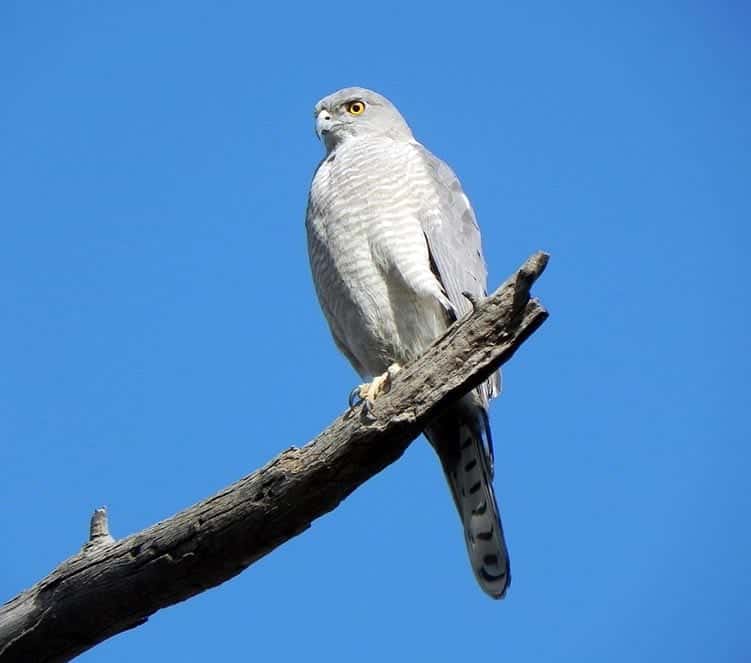
Eurasian sparrowhawk
Habitat: Wooded areas
Size: 13 inches long with a wingspan of 25 inches
Weight: 3.9 to 6.9 Oz
Also known as the northern sparrowhawk, the Eurasian sparrowhawk is a small bird of prey with a bluish-grey upperpart and orange-barred underparts. The bird can be found in any habitat in the temperate and subtropical parts of the Old World. They mostly hunt smaller birds including garden birds, finches, tits, and starlings. They breed in any suitable woodland and build their nests in trees using twigs.
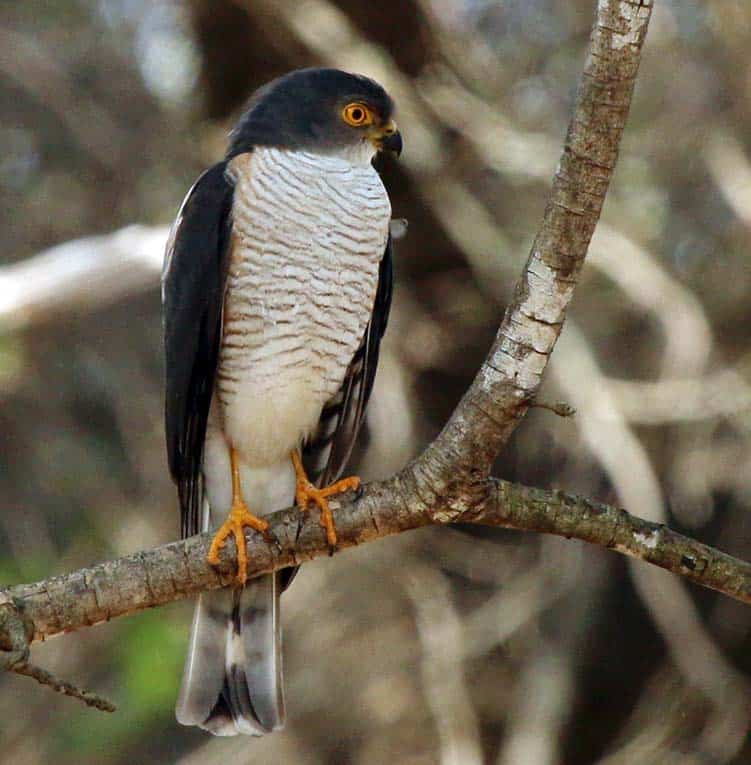
Roadside Hawk
Habitat: Urban areas
Size: 16 inches long
Weight: 8.8 to 10.6 Oz
The roadside hawk is a small raptor found mostly in the Americas. With the exception of dense rainforests, this bird is well adapted to a wide range of ecosystems.
Despite their name suggesting otherwise, these birds prefer the edges of forests and open fields rather than busy roads. It is very aggressive when nesting and has been recorded attacking humans that pass near their nest.
Roadside hawks feed mostly on squamates, insects and small mammals.
Pygmy Falcon
Habitat: Dry bush
Size: 7.8 inches long
Weight: 2.2 Oz
Also known as the African Pygmy Falcon, the pygmy falcon is the smallest raptor in Africa native to eastern and southern Africa. The adults are white below and on the face and grey on the upper part. Females have a chestnut back.
Pygmy falcons have a low and undulating flight and feed mostly on insects, small mammals, and small reptiles. In Kenya, they are found in white-headed buffalo weaver nests whereas in South Africa they are found in red-billed buffalo weaver nests.
Unusually for birds of prey, Pygmy Falcons live in groups, and they’ve even been known to share their nests with sociable weavers, a type of small sparrow.
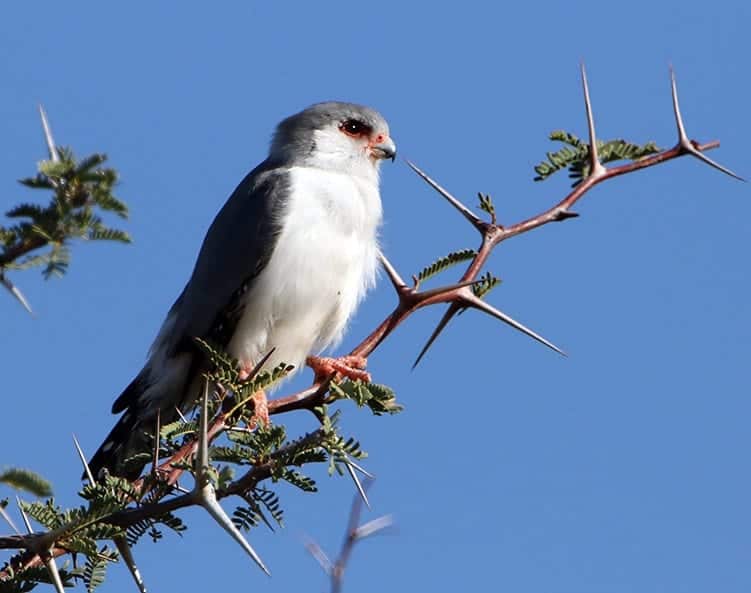
American Kestrel
Habitat: Grasslands, deserts, and meadows
Size: 12.2 inches long with a wingspan of 24 inches
Weight: 2.8 to 5.8 Oz
The American kestrel is also known as the sparrow hawk. It is the smallest and most common falcon in North America. It hunts in an energy-conserving fashion where it perches or hovers in the air, scans for prey, and ambushes. The American kestrel feeds mostly on grasshoppers, lizards, small birds, and mice. It nests in cavities in cliffs, trees, and buildings. It is used in falconry mostly by beginners.
Merlin
Habitat: Upland moor habitats
Size: 13 inches long with a wingspan of 29 inches
Weight: 5.8 to 8.1 Oz
Merlin is a small species of falcon from the Northern Hemisphere. Thanks to their small size, they are swift fliers and very skilled hunters. They prey upon small birds in the size range of quail to sparrows. They have for years been regarded as falconry birds. The population of merlin has increased in North America recently and some of these birds have adapted well to the city life to the extent that they never migrate.
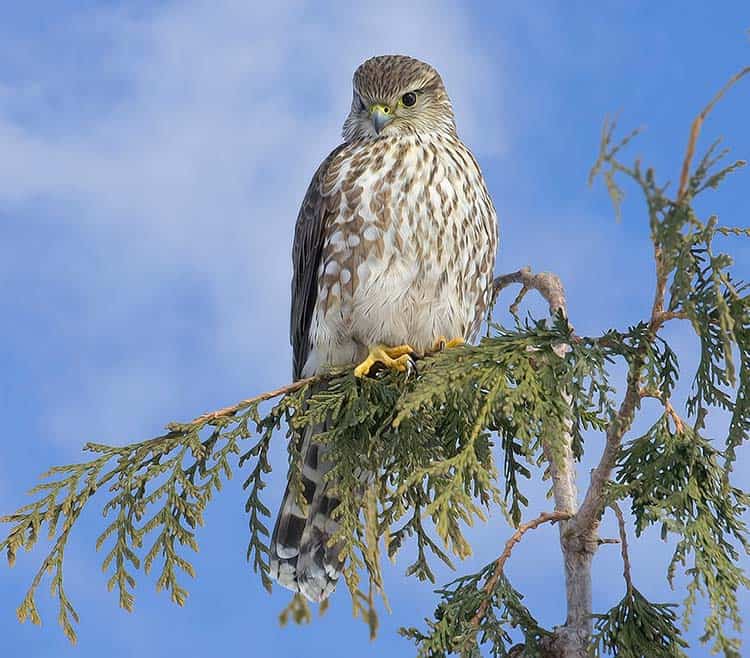
More small birds of prey from around the world
Shikra or Little-banded Goshawk
- Habitat: Woodlands, farmlands, urban parks
- Size: 26-30 cm
- Weight: 110-180 g
Shikras, known as ‘Little-banded Goshawks’, are versatile hunters feeding mainly on small birds, mammals, and reptiles. These birds are widespread across Asia and Africa, adeptly adapting to various habitats, from woodlands to urban parks. Their striking red eyes and the male’s blue-grey plumage make them a fascinating sight.
Pale Chanting Goshawk
- Habitat: Open plains, savannas
- Size: 56-65 cm
- Weight: 485-1100 g
Pale Chanting Goshawks are named for their unique, melodious calls. Native to the open plains and savannas of Sub-Saharan Africa, they feed on a wide range of prey, including small mammals, birds, and reptiles. Remarkably, they are often seen following meerkats to snatch their food.
Crane Hawk
- Habitat: Wetlands, woodlands
- Size: 46-56 cm
- Weight: 300-520 g
Crane Hawks, with their long, slender legs and flexible toes, are specialized hunters. They inhabit wetlands and woodlands from Mexico to northern Argentina, feeding on a variety of animals, including insects, lizards, and nestlings. Their unique hunting technique of probing into tree cavities and bromeliads is truly fascinating.
African Harrier-Hawk (Gymnogene)
- Habitat: Woodlands, savannas, suburbs
- Size: 60-66 cm
- Weight: 800-1100 g
African Harrier-Hawks, also known as Gymnogenes, showcase an interesting feeding behavior: their double-jointed knees allow them to ransack bird nests and crevices for prey. Found throughout Sub-Saharan Africa, they feed on small vertebrates and bird eggs. Despite their large size, their soft grey plumage allows them to blend seamlessly into their surroundings.
Forest Falcons
- Habitat: Tropical rainforests
- Size: Varies among species
- Weight: Varies among species
Forest Falcons are a group of raptors native to the tropical rainforests of Central and South America. They are elusive and poorly studied due to their inaccessible habitats. Their diet is diverse, including mammals, birds, and reptiles. One of their interesting characteristics is their alarm call, which resembles the sound of breaking sticks.
Black-winged Kite
- Habitat: Open plains, savannas
- Size: 31-38 cm
- Weight: 250-300 g
Black-winged Kites, identified by their striking red eyes, inhabit open plains and savannas in parts of Africa, Asia, and Europe. They feed mainly on small mammals and insects. An interesting fact about these birds is their ability to hover in the air, similar to a helicopter while scanning the ground for prey.
Rock Kestrel
- Habitat: Rocky slopes, cliffs
- Size: 30-35 cm
- Weight: 150-250 g
Rock Kestrels are often found perched on high vantage points on rocky slopes and cliffs across Africa and the Middle East. Their diet includes a variety of small mammals, birds, and insects. An interesting adaptation of these birds is their ability to survive in dry habitats with minimal water availability.
Lanner Falcon
- Habitat: Open country, cliffs
- Size: 43-50 cm
- Weight: 530-1050 g
Lanner Falcons are agile hunters native to Africa, southeast Europe, and Asia. They feed mainly on birds, catching them in mid-air. Notably, they are one of the few raptor species that are known to hunt cooperatively, often in pairs, making their hunting tactics a captivating spectacle.
Nankeen Kestrel
- Habitat: Open habitats, farmlands, coasts
- Size: 30-35 cm
- Weight: 120-250 g
Nankeen Kestrels, also known as Australian Kestrels, inhabit diverse open habitats in Australia, New Guinea, and nearby islands. They feed on insects, small mammals, and reptiles. These birds have an intriguing method of hunting, known as ‘hover-hunting’, where they hover in place before diving onto their prey.
Brown Falcon
- Habitat: Grasslands, open woodlands
- Size: 41-51 cm
- Weight: 280-700 g
Brown Falcons are common throughout Australia’s open landscapes, such as grasslands and open woodlands. They feed on small mammals, insects, and reptiles. Interestingly, their color morphs vary with humidity, with darker morphs being more common in humid areas.
Bat Falcon
- Habitat: Forest edges, clearings
- Size: 23-30 cm
- Weight: 130-200 g
Bat Falcons, native to Central and South America, are unique for their diet specialization: they feed predominantly on bats, caught in mid-air during twilight. However, they also eat birds and insects. Their high-speed hunting flights at dusk and dawn are truly a sight to behold.
Aplomado Falcon
- Habitat: Open country, savannas
- Size: 36-40 cm
- Weight: 250-370 g
Aplomado Falcons are slender, long-winged raptors found in the Americas. They predominantly feed on birds and insects. These falcons are known for their cooperative hunting strategy, where pairs work together to flush and capture prey. This striking species is recognized by its bold, contrasting plumage.
The Environmental Significance of Small Birds of Prey
Birds of Prey as Bioindicators
Small birds of prey, like the agile kestrel or elusive sparrowhawk, aren’t just captivating creatures; they’re also essential bioindicators. These avian species are highly sensitive to changes in their environment, making their populations a real-time measure of ecosystem health.
Their unique position in the food chain makes them especially susceptible to pollutants, which accumulate up the food chain.
Survival Rates and Ecosystem Health
The survival rates of these raptors are particularly revealing. Fluctuations can indicate shifts in prey populations, pesticide exposure, or habitat destruction.
Each bird’s survival is like a strand in a complex ecological web; a single break can ripple through the entire system, hinting at larger environmental issues. Notably, decreases in survival rates often precede visible environmental degradation, providing a crucial early warning.
The Interconnectedness of Nature
Thus, monitoring these tiny hunters isn’t just about bird conservation; it’s a window into the well-being of our planet. Their continued survival, in many ways, reflects our own.
Their health serves as a reminder of our responsibility to maintain the balance of nature, underlining the importance of biodiversity and sustainable practices in our daily lives.
List of small birds of prey broken down by types
Falcons and Caracaras (Falconidae):
- American Kestrel
- Aplomado Falcon
- Merlin
- Red-footed Falcon
- Lesser Kestrel
- Nankeen Kestrel
- Eurasian Hobby
- Oriental Hobby
Hawks, Eagles, and Kites (Accipitridae):
- Sharp-shinned Hawk
- Cooper’s Hawk
- Eurasian Sparrowhawk
- African Goshawk
- Grey Goshawk
- Collared Sparrowhawk
- Shikra
- Tiny Hawk
- Black-shouldered Kite
- Letter-winged Kite
Owls (Strigidae and Tytonidae):
- Northern Pygmy Owl
- Eastern Screech Owl
- Western Screech Owl
- Little Owl
- Burrowing Owl
- Elf Owl
- Pearl-spotted Owlet
- African Scops Owl
Understanding Small Raptors: The Mighty Hunters of the Bird World
While eagles and vultures often dominate discussions about birds of prey, the smaller raptors deserve equal recognition for their remarkable hunting prowess and ecological significance. From Britain’s smallest bird of prey to North America’s tiny hunters, these compact predators demonstrate that size isn’t everything in the avian world of hunting.
What Qualifies as a Small Raptor?
Small raptors typically weigh less than 300 grams (10.6 oz) and include various species of falcons, hawks, and owls. Yes, owls are indeed classified as raptors, sharing key predatory characteristics with diurnal birds of prey: sharp talons, hooked beaks, and exceptional hunting abilities. The UK’s smallest bird of prey, the Merlin, measures just 25-30 cm, while North America’s American Kestrel stands as the continent’s most diminutive falcon.
Record Holders: The World’s Smallest Birds of Prey
The title of world’s smallest bird of prey belongs to the Falconet family, with the Black-thighed Falconet weighing a mere 35 grams (1.2 oz). In the owl world, the Elf Owl claims the distinction at just 40 grams (1.4 oz). In the UK, Merlins hold the record, while North America’s smallest raptor is the Northern Saw-whet Owl. These tiny predators demonstrate remarkable efficiency, often taking down prey larger than themselves.
Specialized Hunting Strategies
Small predatory birds have evolved fascinating hunting techniques to compensate for their size. The Pygmy Falcon of Africa specializes in capturing limbless prey like small reptiles and insects, while the Northern Pygmy Owl hunts during daylight hours, contrary to typical owl behavior. In Ontario and other parts of Canada, the Sharp-shinned Hawk displays remarkable agility, navigating dense forests to capture birds in flight. The American Kestrel employs a distinctive hovering technique, conserving energy while scanning for prey below.
Conservation Concerns and Falconry
Many small raptors face population pressures from habitat loss and pesticide use. The Merlin has shown recovery in Britain after decades of decline, while the American Kestrel continues to face challenges across North America. Interestingly, small birds of prey have historical significance in falconry. In South Africa, the Pygmy Falcon was traditionally used by indigenous peoples, while the Merlin was favored by ladies in medieval Europe due to its manageable size. Today, the American Kestrel serves as an entry-level bird for falconry enthusiasts due to its adaptability and trainability.
These small but mighty hunters remind us that ecological importance isn’t measured by size. Whether you’re observing Britain’s smallest bird of prey darting through moorlands or North America’s tiny raptors hunting in grasslands, these small predator birds demonstrate nature’s remarkable ability to create efficient predators in compact packages, each fulfilling vital roles in their respective ecosystems.
Conclusion
From California to the horn of Africa to the far east, there is no shortage of birds of prey. To get the best experience in bird watching, you must study each bird’s habit first. This will help you know where to look. You should also bring a pair of binoculars or a camera with an amazing optical zoom.
More about birds of prey
FAQ
What ecological roles do tiny birds of prey fulfill?
Small raptors serve as crucial population controllers, regulating insects, small mammals, and other birds. They act as vital environmental indicators, with their survival rates directly reflecting ecosystem health. These predators maintain the delicate balance in food webs across diverse habitats.
Which bird holds the title of world’s smallest owl?
The Elf Owl claims this distinction, weighing just 1.4 ounces (40 grams). Native to southwestern United States and Mexico, this tiny nocturnal hunter primarily feeds on insects and small vertebrates, nesting in abandoned woodpecker holes in cacti and trees.
How do miniature raptors hunt effectively despite their size?
Small raptors employ specialized hunting techniques to compensate for their size. Techniques include the American Kestrel’s energy-conserving hovering, the Pygmy Falcon’s group hunting strategy, and the exceptional agility of species like the Sharp-shinned Hawk that can navigate dense vegetation.
Where can you find diminutive birds of prey around the world?
These compact hunters inhabit diverse ecosystems globally. The forest-dwelling Eurasian Sparrowhawk thrives in woodlands, while species like the Burrowing Owl have adapted to desert environments. From Arctic tundra to tropical rainforests, small raptors have evolved to succeed in nearly every habitat.
Why are tiny owls classified as raptors?
All owls, regardless of size, qualify as raptors because they share defining predatory characteristics: sharp, curved talons for capturing prey, hooked beaks for tearing flesh, and exceptional hunting abilities. Their specialized adaptations for capturing and consuming other animals classify them as birds of prey.
How do environmental changes impact smaller birds of prey?
As environmental indicators, small raptors are particularly vulnerable to habitat loss, pesticide use, and climate change. Their population fluctuations often signal broader ecosystem issues. Conservation efforts targeting these species help protect not just the birds themselves but entire ecological communities.
What makes the Merlin notable among British raptors?
The Merlin stands out as one of Britain’s smallest birds of prey, measuring just 25-30 cm. Despite its compact size, this fierce hunter can take down birds larger than itself. After facing population declines, Merlins have shown encouraging recovery in recent decades across British moorlands.
